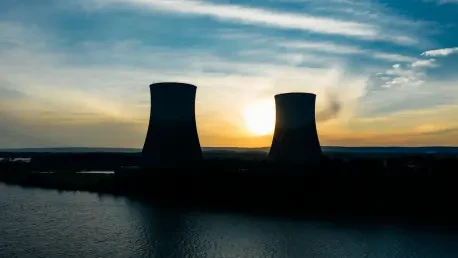As the world grapples with an ever-growing demand for electricity and the urgent need to slash carbon emissions, nuclear energy has emerged as a promising solution to bridge the gap between energy security and climate goals, especially with projections indicating a dramatic surge in global electricity needs through midcentury. The commitment made at COP28 to triple nuclear capacity by 2050 has taken center stage in international discussions. At the recent COP30 in Belém, nuclear power was hailed as a reliable, zero-emission source of electricity and heat, vital for achieving net-zero targets. However, despite this unprecedented momentum, formidable challenges in financing and regulatory frameworks threaten to derail progress. High upfront costs, project risks, and outdated licensing processes stand as significant barriers to scaling up nuclear infrastructure. This article delves into the global push for nuclear energy, examining the political will and innovative strides being made while scrutinizing whether these persistent hurdles can be surmounted to secure a sustainable energy future.
Surging Global Support for Nuclear Power
The pressing need to address escalating energy demands while adhering to stringent decarbonization goals has positioned nuclear power as an indispensable asset in the global energy landscape. Unlike renewable sources such as wind and solar, which can be intermittent, nuclear energy provides a steady, zero-emission output capable of meeting baseload electricity needs. At COP30, nations reiterated their resolve to expand nuclear capacity, acknowledging its dual role in combating climate change and ensuring energy reliability. This urgency is compounded by rapid industrialization and population growth, particularly in developing regions, which are driving electricity consumption to unprecedented levels. The consensus among policymakers is clear: nuclear power must play a central role if the world is to achieve net-zero emissions by 2050. Yet, translating this recognition into actionable outcomes remains a complex endeavor, as the scale of investment and coordination required is immense.
Political backing for nuclear energy has reached historic heights, with 22 countries under the Net-Zero Nuclear initiative reinforcing their pledge to dramatically increase capacity over the coming decades. This growing alignment, particularly evident in the United States and Europe, marks a significant shift from past skepticism toward embracing nuclear as a cornerstone of energy security and industrial competitiveness. Governments are crafting policies to support this transition, viewing nuclear power not just as a climate solution but as a means to bolster national resilience against energy crises. The momentum seen at COP30 reflects a rare unity among nations, with many recognizing that achieving ambitious climate targets hinges on integrating nuclear into their energy mix. However, while this political will sets a promising tone, the practical challenges of implementation loom large, raising questions about whether rhetoric can be matched by results on the ground.
Policy Initiatives and Technological Breakthroughs
In the United States, the Trump 2.0 Administration has rolled out an ambitious agenda dubbed “Make Atoms Great Again,” aiming to quadruple nuclear capacity by 2050 through accelerated licensing reforms and robust workforce development programs. Across the Atlantic, Europe is witnessing a notable political realignment, with frameworks like the European Nuclear Alliance and strategic plans for Small Modular Reactors (SMRs) gaining traction as vital tools for decarbonization. These policy efforts underscore a shared determination to weave nuclear power into the fabric of national energy strategies, despite varying regional approaches. In both regions, the emphasis on governmental support highlights a recognition that private sector initiative alone cannot drive the scale of transformation needed. The focus on streamlining bureaucratic processes and fostering innovation signals a proactive stance, though the effectiveness of these measures remains under scrutiny as projects unfold.
Tangible progress in nuclear energy deployment offers a glimmer of hope amidst broader challenges, with specific milestones illustrating the potential for real-world impact. The restart of the Holtec Palisades plant in Michigan, slated for late this year, represents a groundbreaking achievement as the first decommissioned U.S. nuclear facility to be revived, showcasing the viability of repurposing existing infrastructure. Similarly, in the UK, projects like Sizewell C and Rolls-Royce’s SMR designs are paving the way for faster, more cost-effective deployment of nuclear technology. These advancements, coupled with the promise of advanced reactors that could further reduce costs, demonstrate that nuclear energy is moving beyond mere promises to deliver measurable outcomes. While these successes are encouraging, they also highlight the need for broader replication across regions, a task that demands significant coordination and investment to meet global targets.
Critical Challenges Hindering Expansion
One of the most formidable obstacles to scaling nuclear energy lies in securing adequate financing, as the high upfront costs and inherent project risks deter private investors from committing to large-scale developments. Even with strong political backing, the financial gaps remain a persistent barrier, stalling many initiatives before they can break ground. Solutions such as federal loan guarantees and cost-overrun insurance have been proposed to mitigate these risks, particularly in the U.S., where government intervention is seen as crucial to jump-start projects. Without innovative mechanisms to attract capital and de-risk investments, the ambitious goals set for nuclear capacity expansion risk remaining out of reach. The discussions at COP30 emphasized the necessity of integrating nuclear energy into climate finance frameworks, a move that could unlock the necessary funds but requires global cooperation and policy alignment to implement effectively.
Regulatory inefficiencies and supply chain constraints further complicate the path to nuclear expansion, often delaying projects and inflating costs beyond initial projections. Outdated licensing processes in many countries create bottlenecks, while the lack of standardized reactor designs hinders economies of scale that could make nuclear power more competitive. Additionally, supply chain readiness lags behind the growing demand for materials and skilled labor, posing logistical challenges that threaten timely deployment. Modernizing regulatory frameworks and fostering international alignment on standards are seen as essential steps to streamline development and reduce expenses. However, achieving these reforms faces resistance from entrenched bureaucratic systems and varying national priorities, testing the resolve of global leaders to prioritize nuclear energy. Overcoming these hurdles demands not just policy intent but sustained, coordinated action across borders to ensure the infrastructure keeps pace with ambition.
Path Forward for Nuclear Energy
Reflecting on the discussions and developments surrounding nuclear energy, it’s evident that a pivotal moment was reached at COP30, where global commitment collided with the stark realities of implementation. The historic pledge to triple capacity by 2050 stood as a testament to unified political will, yet the persistent barriers of financing and regulation cast long shadows over those aspirations. Milestones like the Palisades restart and European SMR initiatives proved that progress was achievable, while underscoring how far the journey remained. The narrative that unfolded highlighted a world eager to embrace nuclear power for its clean, reliable energy, but equally aware of the structural obstacles that had to be dismantled. Looking back, the emphasis was on actionable change, with a clear call for innovative financial tools and regulatory modernization to bridge the gap between vision and reality.
Moving ahead, the focus must shift to practical next steps that can transform ambition into tangible outcomes for nuclear energy’s role in a sustainable future. Integrating nuclear projects into broader climate finance mechanisms, as discussed at COP30, offers a promising avenue to mobilize the capital needed to fund large-scale initiatives. Simultaneously, international collaboration on regulatory standardization could accelerate deployment by reducing costs and timelines, ensuring that bureaucratic hurdles don’t stifle innovation. Governments and industry stakeholders should also prioritize building robust supply chains and investing in workforce training to meet the growing demand for skilled labor. By addressing these critical areas with targeted policies and partnerships, the global community can pave the way for nuclear power to fulfill its potential as a cornerstone of decarbonization and energy security, turning past commitments into a lasting legacy.









